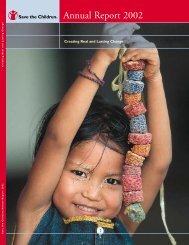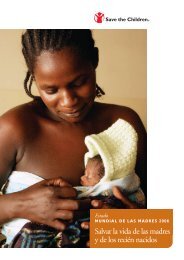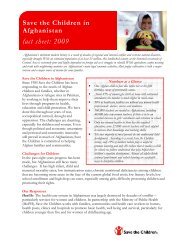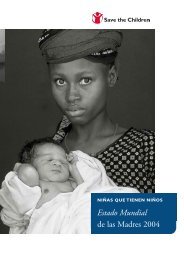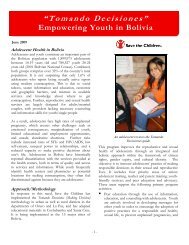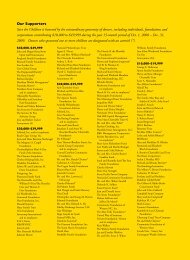Adolescent Sexual and Reproductive Health Toolkit for - UNFPA
Adolescent Sexual and Reproductive Health Toolkit for - UNFPA
Adolescent Sexual and Reproductive Health Toolkit for - UNFPA
You also want an ePaper? Increase the reach of your titles
YUMPU automatically turns print PDFs into web optimized ePapers that Google loves.
MISP: <strong>Adolescent</strong>s <strong>and</strong> STI/HIV Prevention <strong>and</strong> Treatment<br />
Fact Sheet<br />
Why is prevention <strong>and</strong> treatment of<br />
STIs <strong>and</strong> HIV in adolescents important<br />
during emergency situations?<br />
In emergency situations, the risks of STIs <strong>and</strong> HIV<br />
among adolescents can increase: the social structures<br />
that normally influence behavior are broken <strong>and</strong><br />
power disparities between men <strong>and</strong> women may<br />
increase, which can lead adolescents to engage in<br />
consensual or coerced sexual activity at earlier ages.<br />
<strong>Adolescent</strong>s are at greater risk of SEA; <strong>and</strong> although<br />
more research is needed on this issue, livelihood<br />
insecurity may lead adolescents to engage in sex<br />
work in order to meet their survival needs.<br />
What program interventions should be<br />
introduced to address STIs <strong>and</strong> HIV in<br />
adolescents during an emergency?<br />
ASRH program responses during the implementation<br />
of the MISP should focus on prevention of HIV<br />
transmission, although adolescents who present<br />
with symptoms of STIs should receive treatment.<br />
HIV prevention activities in the MISP are limited to<br />
condom distribution, adherence to st<strong>and</strong>ard<br />
precautions <strong>and</strong> safe blood transfusions.<br />
• Condom distribution: Male condoms (<strong>and</strong> if<br />
available, female condoms) should be available to<br />
adolescents free-of-charge at distribution points<br />
located in places that are discreet <strong>and</strong> convenient<br />
to access. ASRH program managers may engage<br />
selected adolescents in the community to help<br />
identify adolescent-friendly distribution points<br />
<strong>and</strong> in<strong>for</strong>m others that condoms are available. In<br />
addition, condoms should be offered to any person<br />
(regardless of sex, age, or marital status) who<br />
requests them or who presents to the health<br />
facility with symptoms of STIs.<br />
It is important that programs supply sufficient<br />
number of condoms to provide <strong>for</strong> the entire<br />
sexually active population, including adolescents.<br />
Male <strong>and</strong> female condoms can be obtained from<br />
<strong>UNFPA</strong> through the Inter-Agency RH Kits, from<br />
the Ministry of <strong>Health</strong>, from other donor agencies,<br />
or can be purchased on the open market.<br />
A minimum of three-months’ supply of condoms<br />
should be procured. 21<br />
• Other prevention of HIV transmission: Clinical care<br />
<strong>for</strong> survivors of sexual assault should include<br />
post-exposure prophylaxis (PEP) <strong>for</strong> HIV <strong>and</strong><br />
presumptive treatment of STIs.<br />
• St<strong>and</strong>ard precautions to prevent transmission of<br />
HIV <strong>and</strong> other blood-borne infections should<br />
be en<strong>for</strong>ced in the health facilities at all times.<br />
Equipment <strong>and</strong> supplies <strong>for</strong> st<strong>and</strong>ard precautions<br />
(sharps containers, gloves, etc.) should be among<br />
the first items procured when implementing the<br />
MISP; health care workers may require refresher<br />
training on st<strong>and</strong>ard precautions. Blood safety<br />
protocols should be introduced to prevent transmission<br />
of HIV or other blood-borne pathogens<br />
through transfusions.<br />
Non-MISP interventions:<br />
• ART/PMTCT: If ART <strong>and</strong> services <strong>for</strong> prevention of<br />
mother-to-child transmission (PMTCT) of HIV were<br />
available be<strong>for</strong>e the crises began, they should be<br />
continued during the emergency, if possible. If<br />
these services weren’t previously available, they<br />
should be introduced as soon as possible once the<br />
emergency has stabilized.<br />
• Treatment of STIs: Although comprehensive STI<br />
programming is not part of the MISP, any man or<br />
woman - regardless of age or marital status- who<br />
presents to a health facility with symptoms of STI<br />
should be treated appropriately <strong>and</strong> offered condoms.<br />
Once the emergency situation has stabilized <strong>and</strong><br />
comprehensive RH services are being planned, ASRH<br />
programs should consider ways to provide adolescents<br />
with access to prevention <strong>and</strong> treatment<br />
services, with special attention to those sub-groups<br />
at higher risk <strong>for</strong> STI <strong>and</strong> HIV. Some ASRH program<br />
interventions to be implemented as part of comprehensive<br />
RH services include:<br />
• Continuation of MISP interventions: The prevention,<br />
treatment <strong>and</strong> referral services that were introduced<br />
during the acute emergency should be continued<br />
<strong>and</strong> strengthened once the situation stabilizes.<br />
36<br />
<strong>Adolescent</strong> <strong>Sexual</strong> <strong>and</strong> <strong>Reproductive</strong> <strong>Health</strong> <strong>Toolkit</strong> <strong>for</strong> Humanitarian Settings




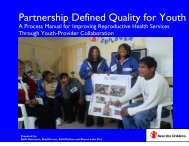

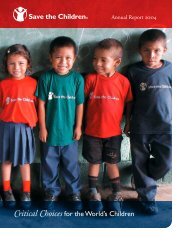
![View full document [PDF 3.39 MB] - PreventionWeb](https://img.yumpu.com/27308954/1/190x245/view-full-document-pdf-339-mb-preventionweb.jpg?quality=85)
